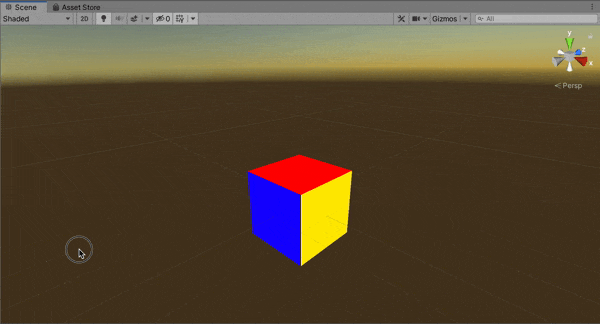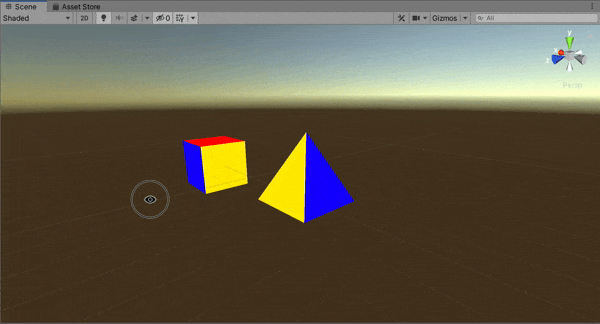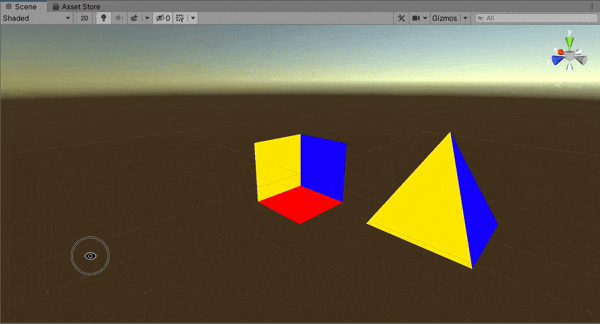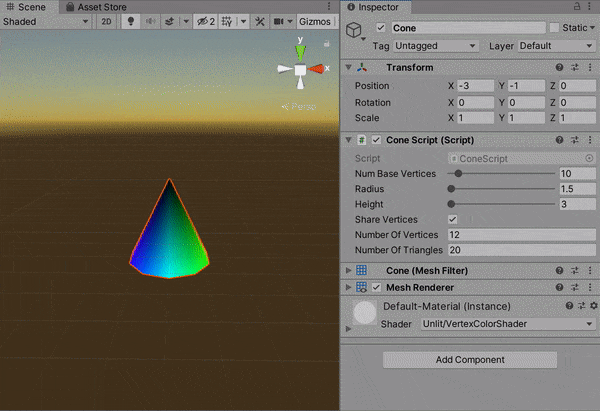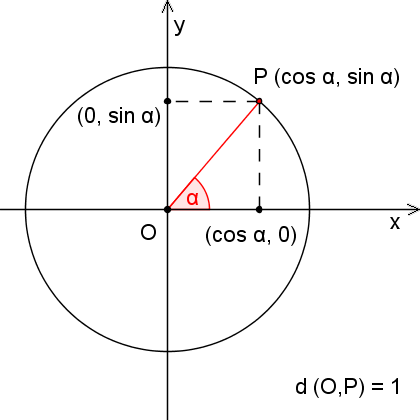The University of Melbourne
In this workshop you will learn about polygonal geometry, and the internal data structures that represent the shape of three-dimensional objects, often known as meshes. To begin, clone this repository and open it in Unity as shown last week. You'll be working with the following assets today:
- MainScene.unity - The scene you should open and work with for the entire workshop.
- GenerateCube.cs - A custom component that generates a cube mesh when the "game" starts.
- VertexColorShader.shader - A Cg/HLSL shader used to render the cube using simple vertex colours. Don't worry about understanding this file in detail today -- you'll learn more about shaders in future weeks.
- VertexColorMaterial.mat - A material asset that utilises the above shader to draw the cube's surface.
Open MainScene.unity in the editor. Press the ‘Play’ button and you should see a
partially rendered cube. Switch to the ‘Scene’ tab so you can manually
navigate the scene.
Use the ‘scene gizmo’ located in the top-right of the viewport in
order to select different angles to view the cube from. Which two faces are
missing?
Note
You might notice this cube is not visible except during play mode. This is because the cube mesh is generated upon starting the scene. This is done inside theGenerateCube.cscomponent, which you'll modify shortly.
Open VertexColorShader.shader, remove the code Cull Off, and save the
file. Make sure you keep this code removed for the remainder of the workshop.
Examine the cube again in the Unity editor. What did Cull Off do?
Add vertex definitions to GenerateCube.cs to complete the cube (add the
missing faces). Culling is now on, so make sure you use the correct vertex
winding order such that the triangles you define are visible from the outside
of the cube. Don't forget to also add corresponding vertex colour definitions, which you should set
to Color.blue.
In a file called GeneratePyramid.cs, write a component that generates an upward
facing square pyramid. The tip of the pyramid should be located
at (0.0, 1.0, 0.0), and each face should have a
unique colour
of your choosing. This will be very similar logically to the cube generator script, so you are
welcome to use it as a template.
Note
Writing the new component alone is not sufficient to render the pyramid. You also need to attach it to a new game object with two other built-in components:
- A Mesh Filter component that will be populated with the generated mesh when the game starts.
- A Mesh Renderer component to actually draw the object. Recall from last week that a material is associated with the mesh renderer to define how the object's surface should be drawn. In this case, you'll want to assign the existing
VertexColorMaterial.matasset so that vertex colour definitions in your mesh are utilised as part of the rendering process.
If you are stuck, you might find it helpful to use the existing Cube game object as a guide!
Remember that the mesh filter/renderer combination is incredibly common in Unity, as most objects have a shape (MeshFilter),
and there needs to be a way of describing the surface of that shape before it can be drawn (MeshRenderer with an assigned material).
You might notice that the mesh filter not just represents the shape but also contains colour data, and that seemingly
contradicts this notion. However this is just per-vertex data -- it is the mesh renderer, and ultimately the
corresponding shader, which interprets this data as actual colours that should be drawn. Another material
might interpret vertex "colours" in an entirely different way, or ignore them altogether. If this is confusing,
don't worry! You'll learn more about shaders and materials in a few weeks.
Move the scene view camera inside the cube. Since back-face
culling is on, you won’t be able to see the inside faces of the cube. Modify
the indices in GenerateCube.cs so
that you can see the interior of the cube instead of the exterior. Carefully read
the associated code comments as these provide some more context about what
the indices actually represent (the indices are defined in step 3, near the end of the file).
Can you think of another way to do this that doesn't involve changing the indices?
Constructing meshes by manually defining vertices/colours is tedious and rarely done in practice (phew!). So far we've only asked you to do this so that you understand the internal data structures required to define a mesh. Nonetheless, the ability to generate a mesh using C# scripting is far from useless if we want to procedurally generate a mesh that is parameterised in some way.
For an extra challenge, try to write a script to procedurally generate a cone. Use
serialized (or public) class attributes to allow parameters of the cone to be set from the
editor, such as the radius. Hint: You can think of a cone as a generalisation
of the pyramid you manually defined in this workshop. The vertices of the base
will form a circle rather than a square, and there’ll be one vertex for the
tip. Maths functions
like Mathf.Sin and Mathf.Cos should help.
In practice, there are artists in a game dev team who use 3D modelling tools to design models in the scene (Blender is worth checking out if you are interested in trying this for yourself). These can be saved using various file formats, many of which can be directly imported by the Unity engine as pre-fabricated game objects. This means writing code to define the shape of an object is not necessary at all!
Note
A model may be more complex than just a mesh. Ultimately, meshes alone cannot capture the complexity of some objects -- for example, how they might be animated, or some of the surface properties (e.g. materials).
As a final extension exercise, search the web for some models and try to import them into your Unity project. Models with the .fbx format are generally well handled by Unity, but there are other formats work well too.
Warning
Always keep in mind copyright and licensing when including external resources in your projects – there are many freebies out there, but licenses may prohibit usage under certain circumstances (i.e. commercial uses).
Remember, it's a great idea to challenge yourself beyond what we explicitly discuss in class. For example, see if you can import a model, but then also "distort" it in some way by accessing the underlying mesh in a C# script (e.g. modify the vertex definitions). You may need to do some additional research in order to do this, but the building blocks of mesh data structures have been demonstrated in this class.
Feel free to reach out on Ed if you have any questions, and most importantly, have fun!
